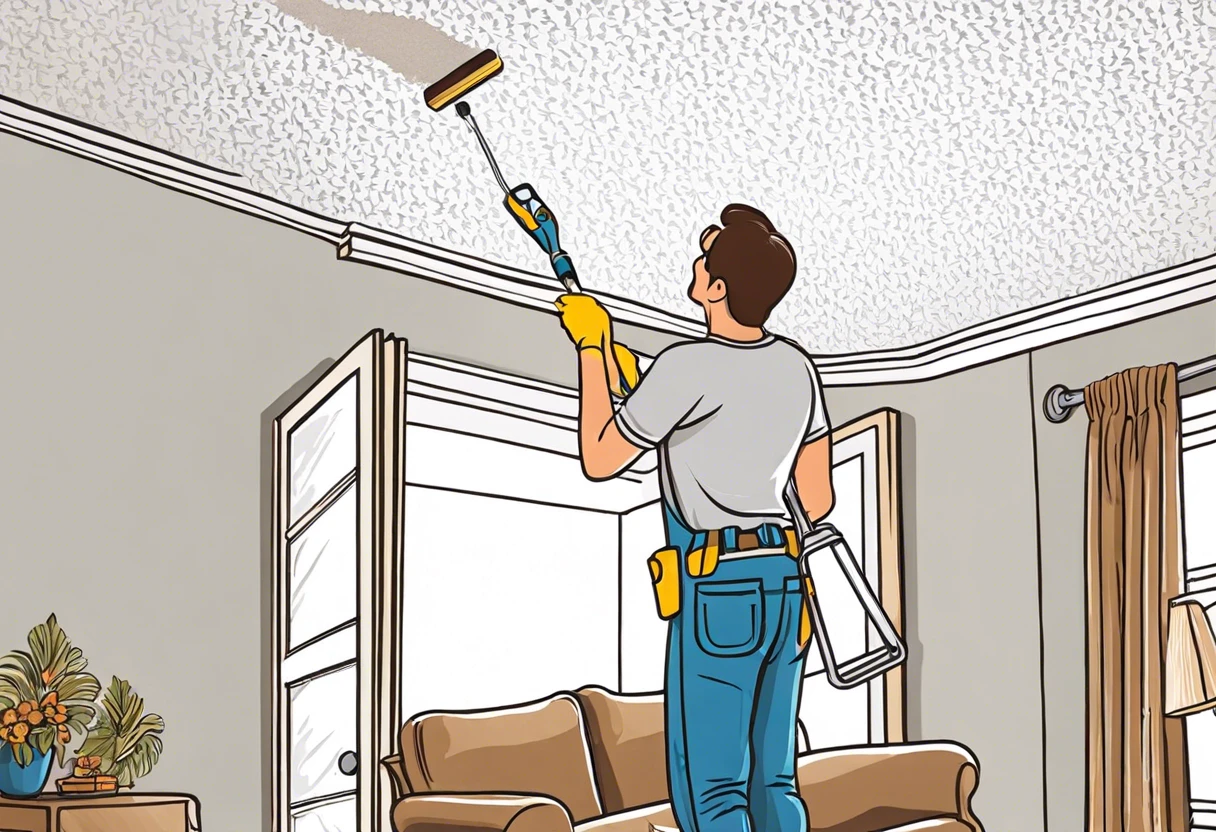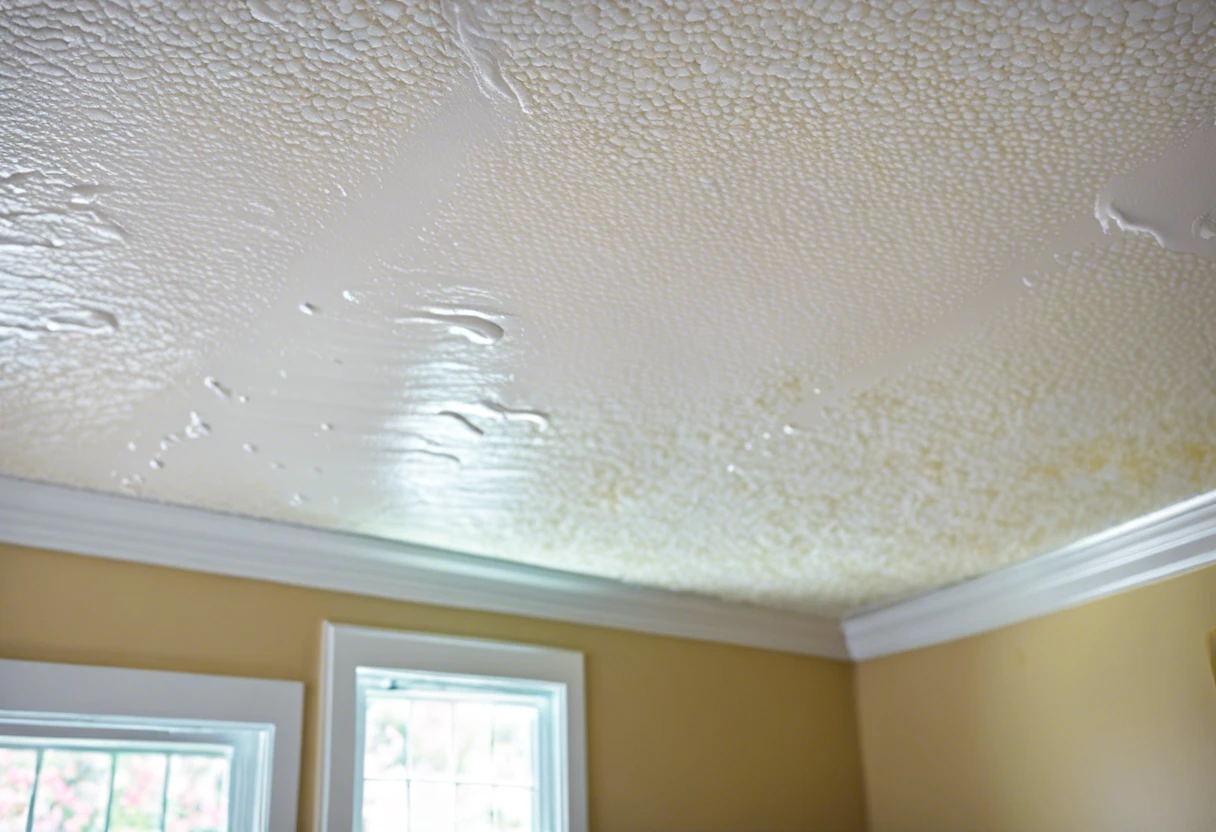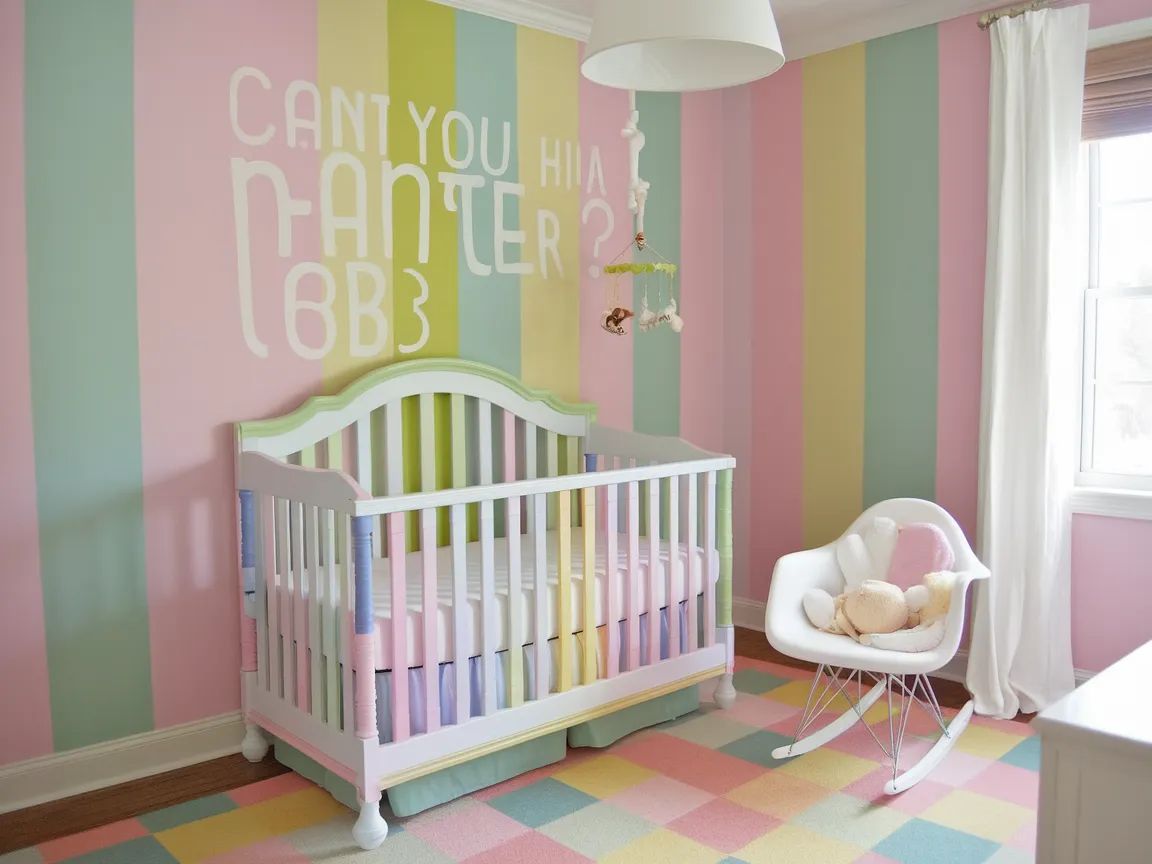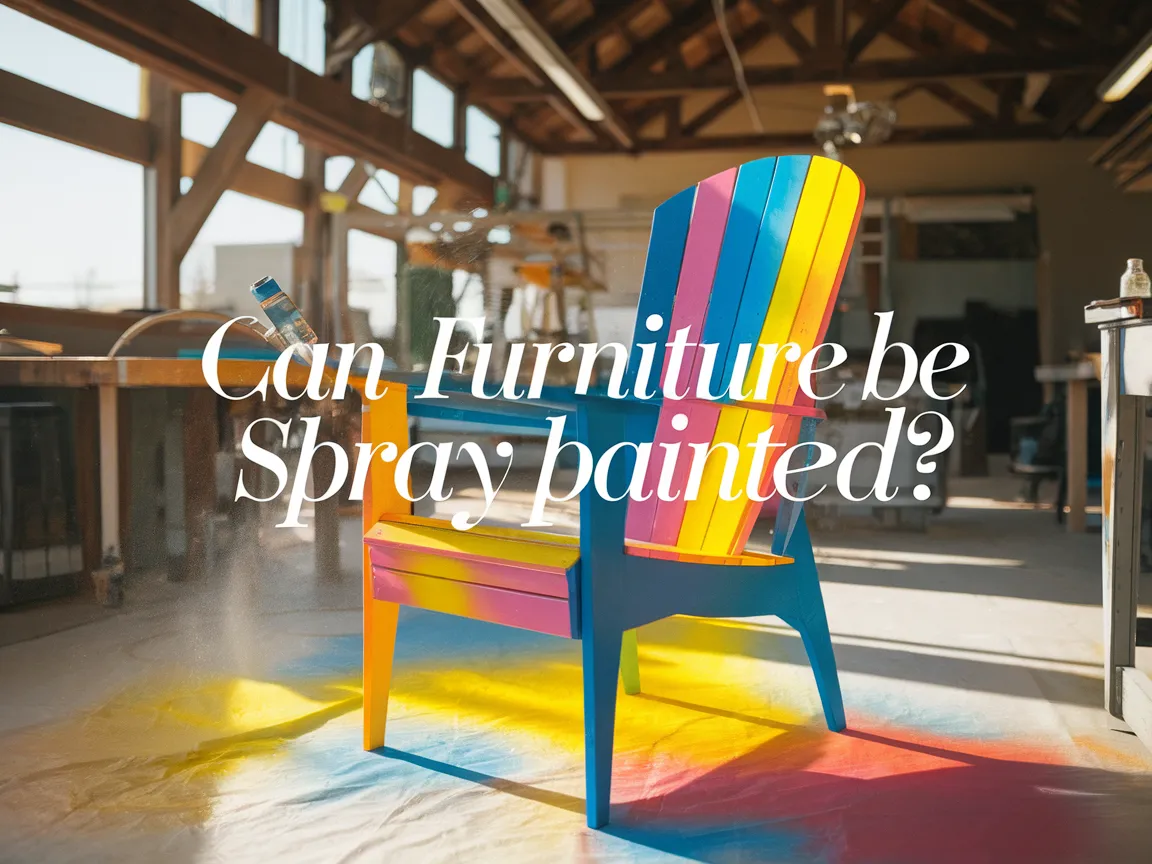Can You Paint Popcorn Ceiling With a Roller?
Published on: April 6, 2025 | Last Updated: January 7, 2025
Written By: Alisha Winters
Popcorn ceiling is a bumpy ceiling made with small, white, popcorn-like bumps. It looks like it has tiny mountains up there, making the room feel cozy, kinda like a fluffy cloud above you.
You might be wondering, can you paint popcorn ceiling with a roller? Well, it’s important to know how because a fresh coat can brighten your space. From my own experience, taking the time to learn the process saved me a lot of headaches later on!
In this guide, we’ll cover essential prep steps, the right techniques for how to paint popcorn ceilings with a roller, recommended colors, paint types, factors that can affect your painting, common problems, and some creative DIY ideas to really make that ceiling pop!
Contents
- 1 Can You Paint Popcorn Ceiling With a Roller?
- 2 What is a Popcorn Ceiling?
- 3 Essential Preparations Before You Start
- 4 Step-by-step Guide to Painting a Popcorn Ceiling With a Roller
- 5 Best Techniques for Painting a Popcorn Ceiling with a Roller
- 6 Comparison of Painting Techniques for Popcorn Ceilings
- 7 Different Types Of Paint Suitable for Popcorn Ceilings
- 8 Factors Affecting the Painting Process for Popcorn Ceilings
- 9 Common Issues Encountered When Painting a Popcorn Ceiling With a Roller
- 10 Finishing Touches for a Flawless Ceiling
- 11 Creative DIY Project Ideas to Enhance Your Popcorn Ceiling
- 12 Tips for Maintaining Your Newly Painted Popcorn Ceiling
- 13 How to Touch Up Minor Imperfections Post-Painting
- 14 Frequently Asked Questions (FAQ)
- 15 Conclusion
- 16 Additional Resources
Can You Paint Popcorn Ceiling With a Roller?
Yes, you can paint a popcorn ceiling with a roller! Use a roller with a thick nap to ensure the texture gets covered well. Choose a good-quality ceiling paint for a smooth finish. Just be gentle to avoid damaging the popcorn texture. If you’re exploring creative projects, you might also wonder can you use acrylic paint on clothing.
The Finishing Touch
A freshly painted wall is a blank canvas. The best way to bring your room to life is with a single piece of statement art that ties everything together.
Browse Wall Art at Big Wall DecorWhat is a Popcorn Ceiling?
A popcorn ceiling, or stucco ceiling, is a textured ceiling with a bumpy, spray-on finish. This style gained popularity from the 1950s to the 1980s, mainly due to its low cost and effectiveness in hiding imperfections, saving about 10% to 20% on plaster and labor costs. If you’re wondering about covering dark hues with lighter shades, you might be interested in how you can paint over textured ceilings effectively.
Now, can you paint popcorn ceilings with a roller? I attempted to paint my textured ceiling with a roller, and it wasn’t as easy as I’d hoped. Those tiny bumps hide more challenges than benefits!
When painting walls, using acrylic paint offers a variety of colors and a smooth finish that may not be suitable for popcorn ceilings due to their unique texture. To learn more about using acrylic paint on walls, consider how the surface texture can affect the application process.
I used it often to create cozy vibes in my old apartment. I learned the importance of using the right roller nap—choose one between 3/8″ (9.5 mm) and 1″ (25 mm) for the best access to the textures. Forgetting this tip made me wish I could paint without all the hassle! If you are curious about techniques on how to paint different materials, take a look at interior painting techniques.
Essential Preparations Before You Start
What do you need to prepare for painting a popcorn ceiling?
- High-Quality Roller: You’ll need a high-nap roller, like a ¾ inch (1.9 Cm) roller, designed specifically for textured surfaces. It covers rough textures efficiently.
- Paint Ladder: A sturdy ladder, such as a 6-foot (1.83 M) stepladder, helps you reach high spots safely.
- Popcorn Ceiling Paint: Choose latex-based ceiling texture paint made specifically for popcorn ceilings. This paint adheres better and prevents drips.
- Duster: Use a quality ceiling duster, like an extendable microfiber one, to remove dust and cobwebs before you start, ensuring a clean surface for smooth application.
We have now covered vital steps, tools, and techniques for preparation. Next, we’ll discuss a step-by-step guide for painting.
The Finishing Touch
A freshly painted wall is a blank canvas. The best way to bring your room to life is with a single piece of statement art that ties everything together.
Browse Wall Art at Big Wall Decor
Also See: How Much Do A Painter Make? Salary Insights

Step-by-step Guide to Painting a Popcorn Ceiling With a Roller
Now, let’s cover the steps for painting a popcorn ceiling with a roller. Follow them closely for the best results!
-
Prepare the Surface
Start by gently scraping off any loose or flaking popcorn texture. Use a garden sprayer filled with water to lightly mist the surface and minimize dust.
This helps ensure the roller adheres properly, providing a smooth finish. If the texture is too damaged, consider replastering or replacing it.
-
Test Your Paint
Before applying a full coat, do a spot test with a small roller. Apply your chosen paint in an inconspicuous area and let it dry to check the texture.
This can prevent surprises later. Trust me, I’ve been shocked before when I chose the wrong sheen!
-
Select the Right Roller
Use a high-nap roller—at least ¾ inch (19 Mm)—for popcorn ceilings to reach into the grooves. Your choice of nap affects the amount of paint applied, so aim for a plush feel.
I’ve found that a thicker nap delivers the best coverage. A small roller can leave too many bare spots.
-
Apply Paint Using the Roller
Start rolling from the edge of the ceiling toward the center. Minimize over-rolling; a light touch creates the perfect texture.
For optimal coverage, work in small sections—typically about 4 ft (1.2 M) long. This helps maintain wet edges and avoids visible seams.
-
Backroll
After applying, backroll the paint immediately with a clean roller. This technique removes bubbles and evens out the coat, enhancing the texture.
When backrolling, apply rhythmic pressure—enough to spread the paint but not much more. This ensures you fill the popcorn properly!
-
Evaluate and Touch Up
Once dry, inspect your work for coverage inconsistencies. Use a small brush for touch-ups in areas needing more paint, focusing on uneven spots.
This finalizes the project, giving it a neat, professional look. Check the manufacturer’s drying time, usually about 2-4 hours, and avoid high humidity!
So far we covered how to paint a popcorn ceiling with a roller. Let’s look at effective techniques for this task next.
Best Techniques for Painting a Popcorn Ceiling with a Roller
Mastering the right techniques can significantly enhance your popcorn ceiling painting experience.
The Zigzag Technique
Using a zigzag pattern helps distribute paint more evenly across uneven surfaces. Here’s how:
- Start from one corner of the ceiling.
- Roll the roller up and down in a zigzag pattern.
- Then, fill in any gaps with horizontal strokes.
This approach ensures the paint fills every nook and cranny of your popcorn texture, leaving no unexpected bare spots!
Sectioning Method
Break the ceiling into smaller sections—about 4 ft (1.2 m) wide—to maintain wet edges and avoid lap marks.
- Work on one section at a time before the paint dries.
- Always overlap slightly with the previously painted area to blend seamlessly.
You should now have a good understanding of effective methods for painting a textured ceiling with a roller. In the next part, we’ll discuss a comparison of painting techniques for textured ceilings. Exploring unconventional design choices can spark creativity in your projects, much like the concept of gravity-defying stairs.
Comparison of Painting Techniques for Popcorn Ceilings
Different methods provide various benefits. Here’s a comparison table for your reference.
| Technique | Description | Best for |
|---|---|---|
| Zigzag Technique | Uses a back-and-forth motion to evenly apply paint. | Even paint coverage |
| Sectioning Method | Divides the ceiling into manageable areas for better control. | Avoiding lap marks |
| Spray Method | Utilizes a spray gun for quick application without damaging texture. | Speed and even coverage |
Consider these techniques when you tackle your popcorn ceiling project. The right method can save you time and effort!
So far we covered the comparison of painting techniques for popcorn ceilings. Let’s look at the various types of paint suitable for them next.
The Finishing Touch
A freshly painted wall is a blank canvas. The best way to bring your room to life is with a single piece of statement art that ties everything together.
Browse Wall Art at Big Wall Decor
Different Types Of Paint Suitable for Popcorn Ceilings
Let’s explore the types of paint you can use for popcorn ceilings: latex paint, acrylic paint, oil-based paint, and textured spray paint.
-
Latex Paint
Latex paint is water-based and easy to clean. It has a low viscosity, allowing for use with a roller designed for textured surfaces.
-
Acrylic Paint
Acrylic paint is durable and adheres well to rough surfaces like popcorn ceilings. A 12mm (1/2 Inch) nap roller is best for coverage and to avoid drips.
-
Oil-based Paint
Oil-based paint provides a glossy finish and excellent durability but takes longer to dry. Use mineral spirits for cleaning rollers with this type.
-
Textured Spray Paint
Textured spray paint replicates the popcorn effect while delivering a fresh coat. Apply in thin layers, as spray paint can be tricky.
From my experience, latex paint is my go-to. It’s easy to work with and cleans up quickly.
Factors Affecting the Painting Process for Popcorn Ceilings
What factors should you consider when painting your popcorn ceiling with a roller?
-
Roller Nap Length: A thicker nap holds more paint, improving coverage on textured surfaces.
-
Paint Consistency: Thinner paint may require more coats, while thicker paint overlaps less.
-
Application Technique: Backrolling ensures even distribution on uneven popcorn textures.
-
Weight of the Roller: Heavier rollers tire your arms faster, making it hard to maintain control.
Common Issues Encountered When Painting a Popcorn Ceiling With a Roller
When my friend tried painting her popcorn ceiling, the texture clumped together due to too much paint. It looked messy!
To fix it, she used a ⅞-inch (22mm) nap roller. This size absorbs better, allowing for even coverage without causing clumps. Preparation is key, right?
Finishing Touches for a Flawless Ceiling
After rolling paint on your popcorn ceiling, wait at least 24 hours before touching it. Use a blower fan set to low to help it dry completely and ensure even coverage.
Inspect the popcorn ceiling for uneven paint spots. Look closely for areas where the texture might remain visible, usually after 48 hours of drying; touch them up with a roller or brush.
Here’s a pro-level tip from my past projects: When using a high-nap roller (19mm or ¾ Inch) on this textured surface, maintain a steady hand to avoid drips, especially in corners.
Creative DIY Project Ideas to Enhance Your Popcorn Ceiling
Ready to jazz up that popcorn ceiling? Try adding texture with plaster for a more modern twist or use fabric to create a stunning, soft finish!
To kick off, grab some lightweight plaster and a trowel. You’re looking at about $50-$80 in materials and a weekend to make it pop!
If you’re wondering, “Can you paint popcorn ceiling with a roller?” I say why not experiment instead! Try a sponge or even a brayer for unique patterns. Those tools surprise you with beautiful results! When you want to explore painting on different surfaces, you might ask can acrylic paint be used on plastic.
Tips for Maintaining Your Newly Painted Popcorn Ceiling
After you’ve perfected your popcorn ceiling, keeping it looking fresh is key.
- Dust Regularly: Use a microfiber duster every few months to keep dust and cobwebs at bay.
- Avoid Heavy Cleaning: Try to avoid using harsh chemicals. A damp cloth is often enough to wipe down any marks.
- Check for Peeling: Every year, inspect the ceiling for any peeling or cracking in the paint. Touch up as needed.
- Humidity Control: If possible, maintain indoor humidity levels between 30-50% to prevent mold growth and damage.
How to Touch Up Minor Imperfections Post-Painting
It’s normal to find small imperfections after painting. Here’s how to handle them.
-
Identify Trouble Spots:
Look for uneven areas or places where the texture peeks through. These are the spots to target.
-
Apply Ceiling Paint:
Use a small artist brush or a foam roller for precise application on affected areas.
-
Blend the Edges:
Feather out the paint beyond the affected area to blend it in seamlessly.
-
Allow Proper Drying:
Make sure to let the touch-up area dry completely—usually 24 hours—before inspecting the work.
Frequently Asked Questions (FAQ)
Can I Use Regular Paint on a Popcorn Ceiling?
Yes, you can use regular paint on a popcorn ceiling. Most people use latex ceiling paint for a smoother finish, which is easier to clean and typically costs around $20 to $50 per gallon.
Is It Difficult to Paint a Popcorn Ceiling?
Yes, painting a popcorn ceiling can be difficult. The texture makes it hard for standard rollers to cover effectively, often requiring multiple coats.
Can You Paint Over Old Paint on a Popcorn Ceiling?
Yes, you can paint over old paint on a popcorn ceiling. Just make sure to clean the surface first to avoid flaking, and you might need a primer if the old paint is very glossy.
What Tools Do I Need to Paint a Popcorn Ceiling?
To paint a popcorn ceiling, you’ll need a paint roller with a 3/4 to 1-inch nap, an extension pole, and a spray gun for best coverage. Expect to spend around $40 for all tools combined.
How Often Should You Paint a Popcorn Ceiling?
You should paint a popcorn ceiling every 5 to 7 years. High humidity areas may require more frequent touch-ups due to potential water damage or mildew growth.
What is the Best Method for Painting a Popcorn Ceiling?
The best method for painting a popcorn ceiling involves using a spray paint technique. This approach allows for even coverage without damaging the texture, making it easier than traditional rolling. If you’re considering painting exterior trim like Azek, it’s important to understand whether Azek can be painted effectively by using specialized products and techniques. Find the guidelines for Azek painting.
How Can I Repair Damaged Areas on a Popcorn Ceiling Before Painting?
To repair damaged areas on a popcorn ceiling, you can use a spray texture product for an even look. This typically costs around $10 to $15 for a can and ensures seamless coverage.
Can You Change the Color Of a Popcorn Ceiling?
Yes, you can change the color of a popcorn ceiling. Using a paint specifically formulated for ceilings can enhance the texture and lighten up your space for about $30 per gallon.
Also See: Can a Toilet Seat Be Painted? Tips for Your Bathroom
Conclusion
I hope this was worth your while. We covered what a popcorn ceiling is, essential preparations, recommended color palettes, different types of paint, factors affecting the process, common issues, and creative DIY project ideas.
So, can you paint popcorn ceiling with a roller? Yes, you can, if you follow the right steps and have the right paint. Just remember to use a thick nap roller and prepare properly. Don’t hesitate to get in touch for further assistance with your ceiling project.
If you’re looking for more tips and insights, check out Paint Answers.
Additional Resources
- Loomis, A. (2011). Figure Drawing for All It’s Worth. New York, NY: Titan Books.
- How To Roll Paint On A Popcorn Ceiling – YouTube
- How to Paint a Popcorn Ceiling (Without Making a Huge Mess)
Experienced interior designer with 15+ years in transforming spaces, blending artistry with expertise in color and design. Rhode Island School of Design graduate, specializing in restorations and modern makeovers.
Ceiling, Interior









